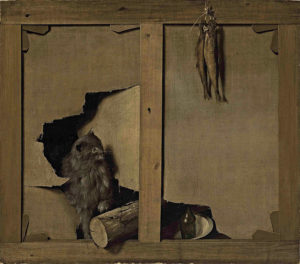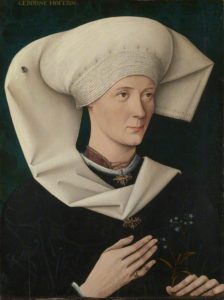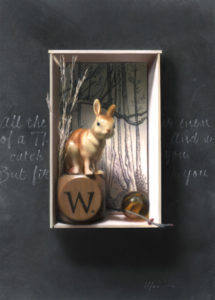
Trompe l’oeil with a cat and a wooden log by Louis-Léopold Boilly
In certain genres or styles, some painters wish to express their talents through deception. Almost as if to say, “I’m so good I made you look twice.” Most often, this takes the form of painting something so realistic that the viewer thinks it is, in fact, real. It’s a strange yet understandable impulse to want to confuse your audience. But this is a far older impulse than people think. While illusions and other tricks in painting are often grouped under the French term trompe l’oeil (literally meaning deceives the eye), highly realistic painting like this predates the term by literal millennia, involving everything from hidden insects to fake curtains.
One of the oldest references to trompe l’oeil involves the ancient Greek painters Zeuxis and Parrhasius. The story goes that Zeuxis created a painting of some grapes so realistic that birds came down to snatch them up. To one-up him, Parrhasius invited Zeuxis into his studio and asked him to pull a curtain aside to reveal a painting. Zeuxis, however, was surprised to find himself simply clawing at a painting of some curtains.
The French painter Louis-Léopold Boilly was the first to coin the term trompe l’oeil in painting. Previously, Boilly had been known for painting portraits and genre scenes, but around the year 1800 switched to these illusionistic paintings. These ranged from tabletops cluttered with papers, coins, and playing cards to the backs of canvases torn open to reveal various objects. Boilly also found that while this showed off his own talent, he could be incredibly playful. One example is a painting on a circular piece of marble meant to resemble a small tabletop. Boilly added several nods to a man named Pourtalès, a member of a Swiss banking family who commissioned the painting. The work includes a variety of Swiss coins, the patron’s portrait in miniature, and some papers which include Boilly’s business card.
But while Boilly was the first to use the phrase trompe l’oeil in reference to painting, he was pulling from a long tradition of illusionistic painting that European artists had been building upon since the Renaissance. However, this was normally reserved for frescoes and other forms of decorative painting rather than anything on a canvas or panel; basically to make a room seem larger than it actually is. Using foreshortening, artists could make flat ceilings appear domed, like what Andrea Pozzo achieved at the Jesuit Church in Vienna. Andrea Mantegna pulled off a similar trick in his fifteenth-century frescoes at the Ducal Palace in Mantua, accompanied by painted-on architectural features like molding and scrollwork that are prominent on the ceiling.

Portrait of a Woman of the Hofer Family
But while most Renaissance-era trompe l’oeil consisted of these frescoes and murals, it also took another form: bugs. Known as the musca depicta (from the Latin for painted fly), fifteenth- and sixteenth-century painters often hid insects like flies in their paintings. Not only was this a display of skill, but many apocryphal stories tell that, while they were apprentices, some artists put insects in their masters’ paintings as a joke. The bugs seemed so lifelike that the master would try to shoo them away only to find that it’s not real. Writers like Filarete and Vasari have told these stories about artists like Giotto and Mantegna. But while these are likely just myths, the flies and other insects are real. Many portraits have these little hidden insects, like Sebastiano del Piombo’s portrait of Cardinal Bandinello Sauli, who has a fly resting on his knee. Then there is Portrait of a Woman of the Hofer Family by an unknown portraitist who included a fly in the woman’s veil. Later on, in the seventeenth century, we start to see these flies infiltrate still-life paintings by Clara Peeters and Balthasar van der Ast.
In the seventeenth century, we start seeing trompe l’oeil on canvas as more than a fly. During this time, Dutch artists in particular were known for creating paintings that gave the appearance of three-dimensional objects. Cornelis Norbertus Gijsbrechts, for example, would create works showing items hung up on a wall partially hidden by a blue curtain drawn back against a background with the grain of unvarnished wood. But probably his simplest yet most impressive work is The Reverse of a Framed Painting. This same style of trompe l’oeil ended up persisting for several centuries. Later examples include the paintings of the nineteenth-century Irish-born American artist William Harnett. His contemporary, Adriaen van der Spelt, also made use of curtains in his work. While mainly specializing in floral still-life paintings, Van der Spelt might be best known for one painting that includes a blue curtain suspended by a rod obscuring about a third of the flowers we’re supposed to see. It was not unusual to have curtain rods installed above paintings in your home at that time. Normally, this was so its owner could create a more dramatic reveal, or possibly because it contained a rather erotic subject. Therefore, a curtain in front of a painting would not have been that unusual for a seventeenth-century viewer, which means it would have been an even greater surprise to see the curtain is itself part of the painting.

Bright Eyes by Anthony Wachulis
To this day, trompe l’oeil continues to serve as an impressive art form. Contemporary painters like Edgar Mueller, John Pugh, and Anthony Wachulis continue this variety of painting. Some artists like Pugh execute it on a much larger scale than his predecessors. They also tend to be publicly viewable, making illusionistic art more accessible. Others, like Wachulis, follow in the footsteps of Gijsbrechts and Harnett, creating hyperrealistic works that make it seem like, at first glance, it’s not a painting in a frame but some small trinkets in a box hanging on the wall. So whenever you see a painting that you have to look twice at, remember that there are centuries of tradition, silliness, and just a hint of ego behind it all.



.jpg)









